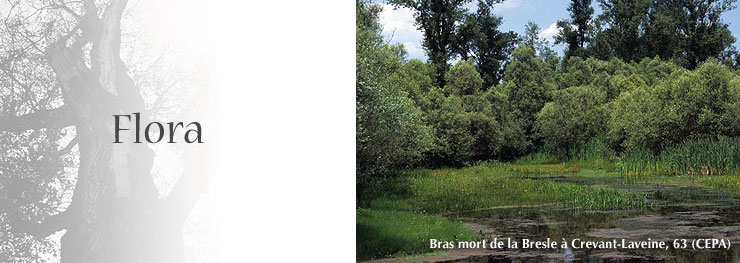|
TRULY ABUNDANT FLORA...
The patchwork of highly diverse ecosystems in the Allier Valley is particularly rich in flora (and fauna). Of Auvergne’s 2,171 plant species, no less than 600 – a quarter of the region's flora – are to be found in the Allier Valley!
Some of these plants can be described as exceptional, due to the rarity of their species or habitat, or because they are so unusual. At least 16 species that are protected throughout France or locally are found in the Auvergne section of the Allier Valley.
...BUT LOCALLY DISRUPTED
Other species are described as "invasive". Often introduced by humans as ornamental garden plants, these exotic species proliferate in some habitats where they take the place of the "natural" vegetation.
|
SOME EXCEPTIONAL PLANT SPECIES
1 - Small Fleabane (Pulicaria vulgaris)
A small, hairy plant belong to the daisy and dandelion family, Fleabane is typical of the damp, sandy beaches beside the Allier. This annual can be recognized by its numerous bobble-shaped yellow flowers. Its decline throughout our country has led to it being protected nationally. However, it is still much in evidence on the banks of the Allier.
2 - Loire Hawkweed (Hieracium peleteranum ligericum)
Also a member of the dandelion family, the Loire Hawkweed, as its name suggests, is native to the beaches of the Loire and the Allier, that is to say that it is found nowhere else, either in Europe or elsewhere in the world. Forming small tufts of hairy leaves with flowers yellow above and red below, it is adapted to areas shaped by the floods, which it resists by means of powerful roots. It is found in grassland communities, often together with Grey Hair-Grass. The Loire Hawkweed is protected in Auvergne, and also in Burgundy.
3 - Grey Hair-grass (Corynephorus canescens)
This grass, which forms very dense blue-green tufts, flowers in June and July. It is a species that colonizes regularly reshaped nutrient-poor sandy beaches, where it is perfectly adapted to drought and trampling. Specific to zones with very sparse ground cover, where much of the soil is bare, Grey Hair-Grass disappears little by little as the vegetation develops to more highly evolved stages.
4 - Flowering Rush (Butomus umbellatus)
Typical of belts of semi-aquatic plants in associated ecosystems, flowering rush can be recognized by its large umbels of pink flowers and long, triangular-section leaves. This remarkable species, found on cut-off lakes and backwaters of the Allier, is an indicator of a good-quality environment.
5 - European White Elm (Ulmus laevis)
A large tree, which is at home in alluvial forests, is difficult to distinguish from its cousin, the Field Elm. But the White Elm is not affected by Dutch Elm Disease, which decimated the Field Elm, and unlike Field Elms, can reach a very respectable size. A little-known tree, the White Elm is still rare all along the Allier, which has led to the species being protected throughout Auvergne.
6 - Black Poplar (Populus nigra)
This tree is a pioneer, together with willows, it colonizes beaches that dry out in summer. It is the precursor of the gradual conquest of banks by vegetation and the establishment of alluvial forest. Some Black Poplars, more than 100 years old, are now listed in the inventory of Auvergne’s exceptional trees because of their impressive size. Although it has not become rare, the species, which populates our rivers naturally, is often replaced by "exotic" varieties of poplar, such as the Italian Poplar, planted for timber or paper production. These almost omnipresent cultivars hybridize with the Black Poplar and, in time, could jeopardize the natural native stock, still found in quantity in the Allier Valley.
|













 Flora
Flora